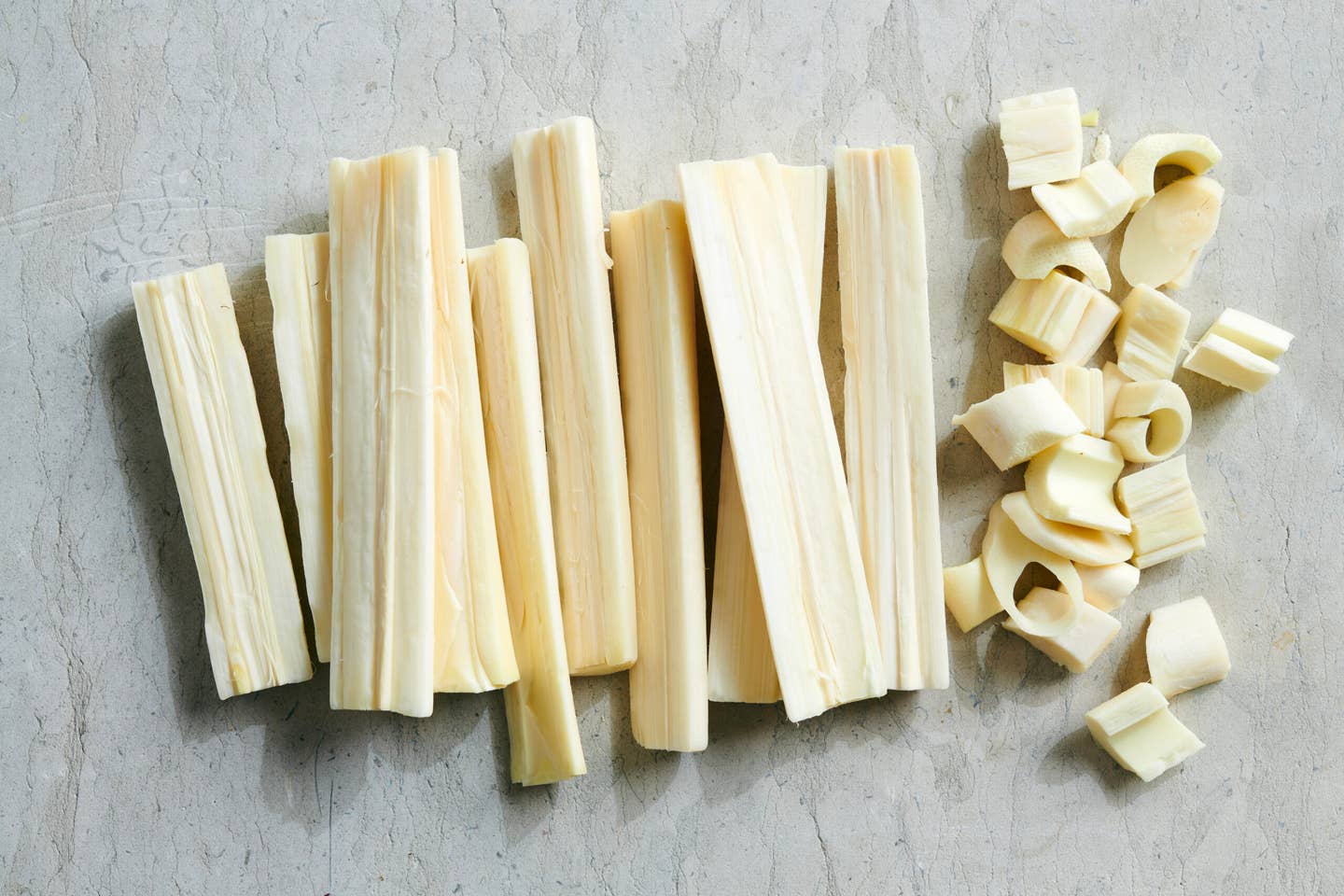
This Underrated Tropical Ingredient Is About to Be Your New Favorite Meat Replacement
Fresh hearts of palm shine in everything from citrusy ceviche to hearty stews.
I tried hearts of palm for the first time when I was 8 years old living in Bogotá, Colombia. I was at my aunt’s home, where my older cousin Juliana was preparing palmitos gratinados (hearts of palm with heavy cream, broiled with gruyère cheese) for her new boyfriend, who was coming over to meet her mother for the first time. There was so much nervousness in the air; they clearly wanted to impress this new beau. Though I merely grated lime zest for dessert and helped set the table, I felt included in an adult event for the first time in my life, and hearts of palm became forever embedded as a delicacy in my mind, exclusive to special occasions.
Hearts of palm are the inner core of different palm tree varieties, which mostly grow in Central and South America and Southeast Asia. Each tender core takes about two years to grow, before they are harvested, cut, preserved in brine (either canned or in jars), and sold. Different kinds of palm trees produce hearts with different consistencies; some are soft and creamy, while others are firm and fibrous. What remains constant is the ingredient’s delicate flavor: clean and grassy, with a touch of sweetness. The mild taste and meaty texture make them a perfect vehicle for all sorts of sauces. Throughout Latin America, you will often find them in salads, or grilled and drizzled with olive oil and lime juice. They appear in soups, too, like the creamy mote de palmito commonly served during Easter in Colombia’s Sinú River valley.
Today, this stalky, off-white vegetable also has significant political underpinnings. It has become an incentive for families in Colombia’s Putumayo region to replace their illicit coca crops with palm trees—part of a government strategy to give communities a safe, sustainable, and profitable livelihood. But the harvesting of wild hearts of palm has also faced backlash in certain countries, where environmentalists have protested against the deforestation consequences associated with their cultivation. As a solution, sustainability-minded producers in countries like Costa Rica, such as La Cima and Palmito Fresco, have broadened the range of products that can be made with hearts of palm—think pasta replacements and lasagna sheets—which can now be found in natural food and health stores in the U.S. Farms like Puna Gardens also commit to sustainable harvesting techniques that don’t disrupt the regeneration of new palms.
Fresh hearts of palm can be hard to obtain in the Northern Hemisphere, and I do wish they were easier to find. When they are fresh, the texture is crisper and the taste is richer. I often buy them fresh online, through sites like Melissa’s and Fresh & Wild.
Whether you’re cooking fresh hearts of palm or the canned or jarred varieties, there is so much you can do with them. Here are some ways to enjoy the versatile ingredient.
Add to Soups and Stews
The next time you make your favorite meat stew or curry, try replacing the protein with hearts of palm cut into one-inch pieces—the ingredient’s subtle flavor is a wonderful canvas for bright, bold seasonings and will do a good job of soaking up luxurious gravies.
Bake, Roast, or Grill Them
Hearts of palm won’t fall apart easily, so they’re perfect for the oven or grill. Sprinkle with flaky salt and freshly cracked black pepper and drizzle with oil before cooking them up. When you’re ready to eat, sprinkle the hearts of palm with toppings like sesame seeds or toasted nuts, and serve them with a side of your favorite sauce, like romesco or tahini.
Whip Up a Ceviche
Try swapping out the fish or seafood that would traditionally be in a ceviche for hearts of palm instead. The ingredient’s meaty texture adds so much bite to the dish that you won’t miss the seafood at all. When making your own, try experimenting with different combinations of fruits and vegetables. I developed a ceviche recipe featuring pomelo, grapefruit, and hearts of palm for my most recent cookbook, Colombiana, and the zest of the citrus marries beautifully with the delicate flavors of the hearts of palm.
Make Some Tacos
Hearts of palm make for a delicious plant-based taco filling. I like to split the stalks in half vertically, drizzle with olive oil, and grill for 3 to 4 minutes on each side. Then, I cut them into pieces and add some chili oil to amp up the heat. All that’s left to do is spoon them over tortillas, and you have yourself the makings for a vegan taco night.
Recipe
Keep Reading
Continue to Next Story










